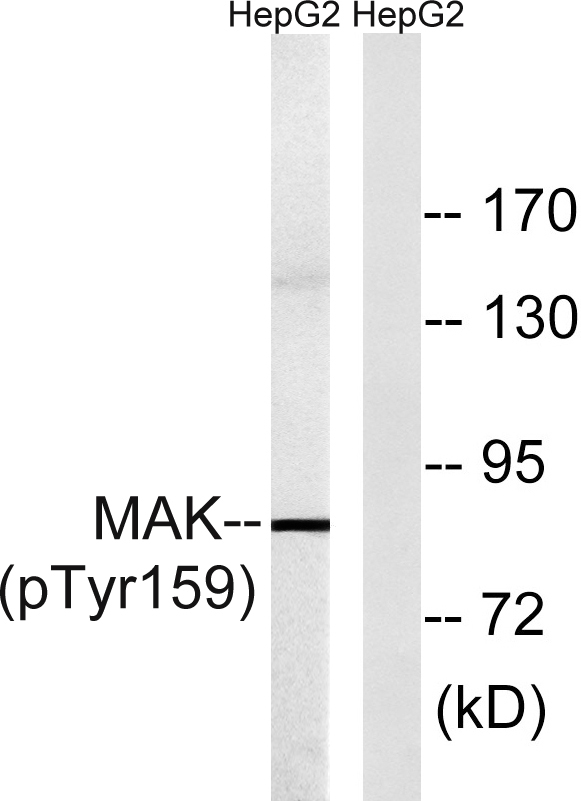MAK (phospho Tyr159) Polyclonal Antibody
- Catalog No.:YP0423
- Applications:WB;ELISA
- Reactivity:Human;Mouse;Rat
- Target:
- MAK
- Gene Name:
- MAK
- Protein Name:
- Serine/threonine-protein kinase MAK
- Human Gene Id:
- 4117
- Human Swiss Prot No:
- P20794
- Mouse Gene Id:
- 17152
- Mouse Swiss Prot No:
- Q04859
- Rat Gene Id:
- 25677
- Rat Swiss Prot No:
- P20793
- Immunogen:
- The antiserum was produced against synthesized peptide derived from human MAK around the phosphorylation site of Tyr159. AA range:126-175
- Specificity:
- Phospho-MAK (Y159) Polyclonal Antibody detects endogenous levels of MAK protein only when phosphorylated at Y159.
- Formulation:
- Liquid in PBS containing 50% glycerol, 0.5% BSA and 0.02% sodium azide.
- Source:
- Polyclonal, Rabbit,IgG
- Dilution:
- WB 1:500 - 1:2000. ELISA: 1:40000. Not yet tested in other applications.
- Purification:
- The antibody was affinity-purified from rabbit antiserum by affinity-chromatography using epitope-specific immunogen.
- Concentration:
- 1 mg/ml
- Storage Stability:
- -15°C to -25°C/1 year(Do not lower than -25°C)
- Other Name:
- MAK;Serine/threonine-protein kinase MAK;Male germ cell-associated kinase
- Observed Band(KD):
- 85kD
- Background:
- The product of this gene is a serine/threonine protein kinase related to kinases involved in cell cycle regulation. Studies of the mouse and rat homologs have localized the kinase to the chromosomes during meiosis in spermatogenesis, specifically to the synaptonemal complex that exists while homologous chromosomes are paired. Mutations in this gene have been associated with ciliary defects resulting in retinitis pigmentosa 62. Alternative splicing results in multiple transcript variants. [provided by RefSeq, Jan 2016],
- Function:
- catalytic activity:ATP + a protein = ADP + a phosphoprotein.,function:Could play an important function in spermatogenesis.,similarity:Belongs to the protein kinase superfamily.,similarity:Belongs to the protein kinase superfamily. CMGC Ser/Thr protein kinase family. CDC2/CDKX subfamily.,similarity:Contains 1 protein kinase domain.,tissue specificity:Expressed mainly in testicular cells at and after meiosis.,
- Subcellular Location:
- Nucleus. Cytoplasm, cytoskeleton, microtubule organizing center, centrosome. Cytoplasm, cytoskeleton, spindle. Midbody. Cell projection, cilium, photoreceptor outer segment . Photoreceptor inner segment. Localized in both the connecting cilia and the outer segment axonemes (By similarity). Localized uniformly in nuclei during interphase, to the mitotic spindle and centrosomes during metaphase and anaphase, and also to midbody at anaphase until telophase. .
- Expression:
- Expressed in prostate cancer cell lines at generally higher levels than in normal prostate epithelial cell lines. Isoform 1 is expressed in kidney, testis, lung, trachea, and retina. Isoform 2 is retina-specific where it is expressed in rod and cone photoreceptors.
- June 19-2018
- WESTERN IMMUNOBLOTTING PROTOCOL
- June 19-2018
- IMMUNOHISTOCHEMISTRY-PARAFFIN PROTOCOL
- June 19-2018
- IMMUNOFLUORESCENCE PROTOCOL
- September 08-2020
- FLOW-CYTOMEYRT-PROTOCOL
- May 20-2022
- Cell-Based ELISA│解您多样本WB检测之困扰
- July 13-2018
- CELL-BASED-ELISA-PROTOCOL-FOR-ACETYL-PROTEIN
- July 13-2018
- CELL-BASED-ELISA-PROTOCOL-FOR-PHOSPHO-PROTEIN
- July 13-2018
- Antibody-FAQs
- Products Images

- Western blot analysis of lysates from HepG2 cells treated with PMA 125ng/ml 30', using MAK (Phospho-Tyr159) Antibody. The lane on the right is blocked with the phospho peptide.



